Accept all cookies Accept only essential cookies See our Cookie Notice

About ESA
The European Space Agency (ESA) is Europe’s gateway to space. Its mission is to shape the development of Europe’s space capability and ensure that investment in space continues to deliver benefits to the citizens of Europe and the world.
Highlights
ESA - United space in Europe
This is ESA ESA facts Member States & Cooperating States Funding Director General Top management For Member State Delegations European vision European Space Policy ESA & EU Space Councils Responsibility & Sustainability Annual Report Calendar of meetings Corporate newsEstablishments & sites
ESA Headquarters ESA ESTEC ESA ESOC ESA ESRIN ESA EAC ESA ESAC Europe's Spaceport ESA ESEC ESA ECSAT Brussels Office Washington OfficeWorking with ESA
Business with ESA ESA Commercialisation Gateway Law at ESA Careers Cyber resilience at ESA IT at ESA Newsroom Partnerships Merchandising Licence Education Open Space Innovation Platform Integrity and Reporting Administrative Tribunal Health and SafetyMore about ESA
History ESA Historical Archives Exhibitions Publications Art & Culture ESA Merchandise Kids Diversity ESA Brand Centre ESA ChampionsSpace in Member States
Find out more about space activities in our 23 Member States, and understand how ESA works together with their national agencies, institutions and organisations.
Science & Exploration
Exploring our Solar System and unlocking the secrets of the Universe
Go to topicAstronauts
Missions
Juice Euclid Webb Solar Orbiter BepiColombo Gaia ExoMars Cheops Exoplanet missions More missionsActivities
International Space Station Orion service module Gateway Concordia Caves & Pangaea BenefitsLatest
Space Safety
Protecting life and infrastructure on Earth and in orbit
Go to topicAsteroids
Asteroids and Planetary Defence Asteroid danger explained Flyeye telescope: asteroid detection Hera mission: asteroid deflection Near-Earth Object Coordination CentreSpace junk
About space debris Space debris by the numbers Space Environment Report In space refuelling, refurbishing and removingSafety from space
Clean Space ecodesign Zero Debris Technologies Space for Earth Supporting Sustainable DevelopmentApplications
Using space to benefit citizens and meet future challenges on Earth
Go to topicObserving the Earth
Observing the Earth Future EO Copernicus Meteorology Space for our climate Satellite missionsCommercialisation
ESA Commercialisation Gateway Open Space Innovation Platform Business Incubation ESA Space SolutionsLatest
Enabling & Support
Making space accessible and developing the technologies for the future
Go to topicBuilding missions
Space Engineering and Technology Test centre Laboratories Concurrent Design Facility Preparing for the future Shaping the Future Discovery and Preparation Advanced Concepts TeamSpace transportation
Space Transportation Ariane Vega Space Rider Future space transportation Boost! Europe's Spaceport Launches from Europe's Spaceport from 2012Latest

Lunar south pole mosaic - annotated
Thank you for liking
You have already liked this page, you can only like it once!
This mosaic of the lunar south pole was obtained with images taken by the Advanced Moon Imaging Experiment (AMIE) on board ESA's SMART-1. The pictures were taken between Dec 2005 and March 2006, during the lunar southern summer. The mosaic, composed of about 40 images, covers an area of about 500 by 150 km. The lunar near-side facing Earth is at the top of the map, while the far-side is at the bottom. A number of interesting lunar craters are indicated:
Shackleton, visible left-centre of the mosaic, is the crater which contains the lunar south pole within its rim. It is nearly circular (about 19 km across, centered at 89.9° south, 0.0° east), with a clear rim and a relatively flat crater floor marked by smaller craters inside. The southern part of its interior is permanently in shadow, making it difficult to image, but it is expected to be bowl-shape due to its modest size. It was named after the British polar explorer Ernest Shackleton.
Faustini, in the centre of the mosaic (87.3° south, 77.0° east), is a crater about 39 km across. The Lunar Prospector mission found that this crater has a higher-than-normal concentration of hydrogen. It was named after the Italian polar geographer explorer Arnaldo Faustini (1872-1944).
Shoemaker crater has been named after the geologist whose ashes were on board the Lunar Prospector spacecraft that impacted on the crater floor. 50 km in diameter, the crater is centred at 89.9° south, 0.0° east and is located between the Shackleton and Faustini craters. Lunar Prospector found that this crater has a higher-than-normal concentration of hydrogen. On July 1999, the mission crashed into the crater to create a plume of water vapor, but no detection was reported.
De Gerlache crater (diameter 32 km, centered at 88.5° south, 87.1° west) is located near Shackleton crater. Its floor is permanently shadowed. On the SMART-1 AMIE mosaic an illuminated saddle can be seen, bridging its rim to Shackleton. The crater is named after Adrien de Gerlache (1866, 1934), the Belgian antarctic explorer.
Amundsen is a large impact crater, about 105 km across, located along the southern lunar limb (84.5° south, 82.8° east), with its rim situated 110 km from the south pole. From Earth, this crater is viewed nearly from the side, illuminated by oblique sunlight. The crater rim is slightly distended along the southern edge, and the terraced surface is asymmetrical. Central peaks, that were formed from the rebound of the crust after the impact are quite apparent with their shadow projected over the flat floor.
-
CREDIT
ESA/SMART-1/Space-X (Space Exploration Institute) -
LICENCE
CC BY-SA 3.0 IGO or ESA Standard Licence
(content can be used under either licence)
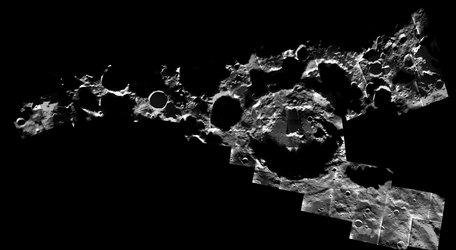
A peppering of craters at the Moon’s south pole
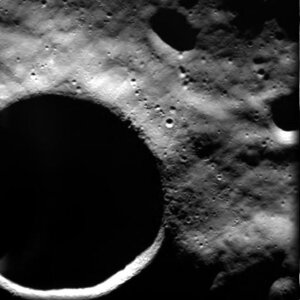
SMART-1 view of Shackleton crater at lunar South Pole
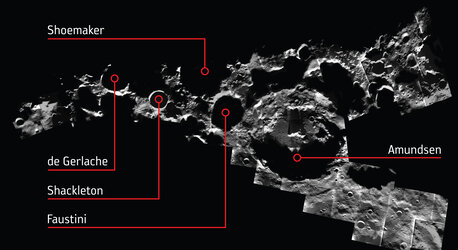
Annotated lunar south pole mosaic
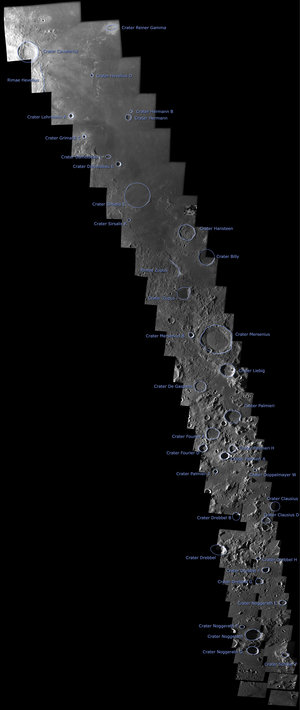
Annotated strip of the lunar near side including SMA…
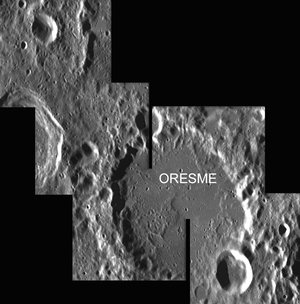














 Germany
Germany
 Austria
Austria
 Belgium
Belgium
 Denmark
Denmark
 Spain
Spain
 Estonia
Estonia
 Finland
Finland
 France
France
 Greece
Greece
 Hungary
Hungary
 Ireland
Ireland
 Italy
Italy
 Luxembourg
Luxembourg
 Norway
Norway
 The Netherlands
The Netherlands
 Poland
Poland
 Portugal
Portugal
 Czechia
Czechia
 Romania
Romania
 United Kingdom
United Kingdom
 Slovenia
Slovenia
 Sweden
Sweden
 Switzerland
Switzerland
























